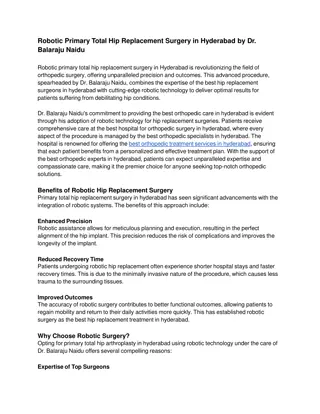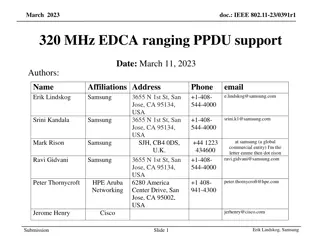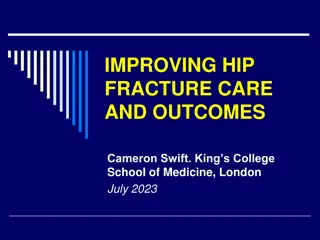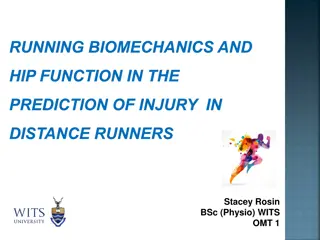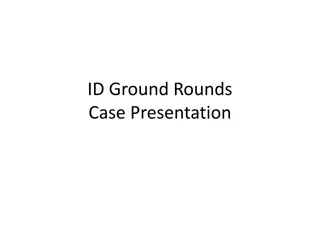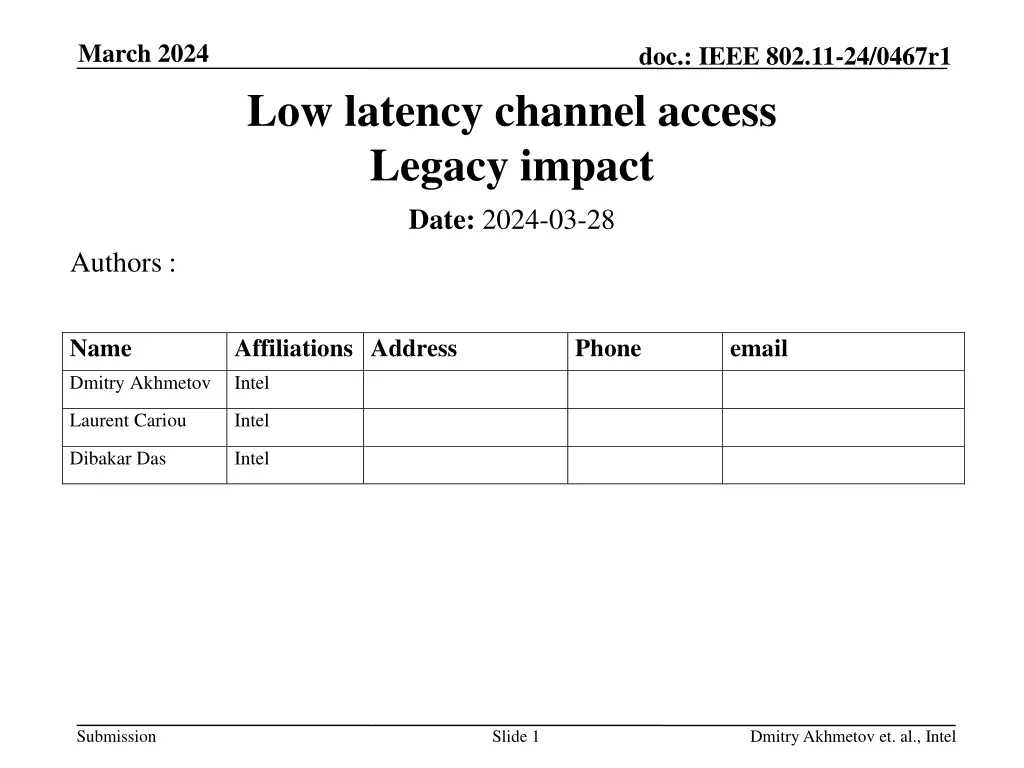
IEEE 802.11-24 Impact on Legacy Devices: DS Usage Effects
Explore the impact of UHR device utilization of DS in IEEE 802.11-24 on legacy devices within a BSS, focusing on STAs using DS for LL frame transmission and its implications on others. Learn about the proposed mechanisms for low latency channel access and high priority EDCA.
Download Presentation

Please find below an Image/Link to download the presentation.
The content on the website is provided AS IS for your information and personal use only. It may not be sold, licensed, or shared on other websites without obtaining consent from the author. If you encounter any issues during the download, it is possible that the publisher has removed the file from their server.
You are allowed to download the files provided on this website for personal or commercial use, subject to the condition that they are used lawfully. All files are the property of their respective owners.
The content on the website is provided AS IS for your information and personal use only. It may not be sold, licensed, or shared on other websites without obtaining consent from the author.
E N D
Presentation Transcript
March 2024 doc.: IEEE 802.11-24/0467r1 Low latency channel access Legacy impact Date: 2024-03-28 Authors : Name Affiliations Address Phone email Dmitry Akhmetov Intel Laurent Cariou Intel Dibakar Das Intel Submission Slide 1 Dmitry Akhmetov et. al., Intel
March 2024 doc.: IEEE 802.11-24/0467r1 Recap from 11-23/1065r0: solution Proposal is to isolate STAs with prioritized access from the rest of the STAs at the beginning of a contention period Achieve this by allowing these STAs to transmit a Defer Signal at the beginning of a contention period to force all STAs that are not sending the Defer Signal to have CCA busy/IEFS set and not participate in the contention period If multiple of these STAs have prioritized access, they will transmit the same Defer Signal at the same time with the same result on other STAs (CCA busy) And then to allow for a contention only between the STAs with prioritized access Only STAs that have sent a Defer Signal can participate in this immediately following contention More degrees of freedom for the contention parameters setting to avoid collisions without loosing priority don t necessarily need to be too aggressive in order to scale to a larger number of STAs while ensuring low collision rates (contrary to AC_VO) Example: A device with the traffic in AC_VO use legacy EDCA to transmit data. Device is eligible to send DS signal if it experience a failure after using legacy EDCA and doubled its contention window After successfully attempting transmission using DS STA fall back to normal EDCA operations Submission Slide 2 Dmitry Akhmetov et. al., Intel
March 2024 doc.: IEEE 802.11-24/0467r1 Recap from 11-23/2126r0 High Priority EDCA (HiP EDCA) mechanism based on transmission of a dedicated signal/frame prior the start of EDCA contention allow to improve tail latency : 90-95-99th percentiles in both isolated BSS case and multi-BSS setup In situations with and without hidden nodes The repetition of DS signal (i.e. an AP reply with same DS signal) has limited affect on tail latency improvement In terms of design it is better to have Unique DS signal rather than Common one, i.e. signal to be specific to a BSS For simplicity it is better to have it in a form of short MAC frame with duration field and TA address Rules to send DS signal need to be discussed Frequency of transmission Eligibility for transmission Currently propose use to use DS for AC[X] after Y failure Where Y is specific for X AIFSN boundary for transmission Submission Slide 3 Dmitry Akhmetov et. al., Intel
March 2024 doc.: IEEE 802.11-24/0467r1 New material: Impact on legacy devices What is the effect on legacy devices when UHR device use DS In a BSS a set of STAs is using DS for LL frame transmission and other don t One (or more) BSS use DS and another (or more) others don t A mix of above Submission Slide 4 Dmitry Akhmetov et. al., Intel
March 2024 doc.: IEEE 802.11-24/0467r1 Simulation configuration 80meters Enterprise-like layout 1, 2 or 4 BSSes with variable number of STAs: 5,6,..,15, 16 Out of which 2, 3 or 4 are ULL STAs Other STA has bidirectional full buffer BE traffic. 2 4 5 7 9 10 12 14 15 17 19 20 22 24 25 27 29 30 32 34 35 37 39 40 42 44 45 47 49 50 52 54 55 57 59 60 62 64 65 67 69 70 72 74 75 77 79 2 1 2 5 6 4 3 4 7 8 7 1 2 3 4 5 6 7 5 7 9 10 13 14 9 11 12 15 16 10 1 2 5 6 12 3 4 7 8 14 3 4 5 6 7 6 1 2 15 9 10 13 14 17 11 12 15 16 19 20 1 2 5 6 22 3 4 7 8 24 6 7 5 1 2 3 4 5 25 9 10 13 14 27 11 12 15 16 29 30 1 2 5 6 32 3 4 7 8 34 80meters 1 2 3 4 5 6 7 4 35 4 9 10 13 14 37 11 12 15 16 39 # STAs # of VO STAs % of VO STA 5 2 40 6 2 33 7 2 29 8 2 25 9 3 33 10 3 30 11 3 27 12 3 25 13 4 31 14 4 29 15 4 27 16 4 25 40 1 2 5 6 42 3 4 7 8 44 4 5 6 7 3 1 2 3 45 3 9 10 13 14 47 11 12 15 16 49 50 1 2 5 6 52 3 4 7 8 54 7 2 1 2 3 4 5 6 55 2 2 9 10 13 14 57 11 12 15 16 59 60 1 5 6 62 3 4 7 8 64 2 3 4 5 6 7 1 1 65 9 10 13 14 67 5 1 11 12 15 16 69 2x2x20Mhz @ MCS0 and @ MCS7 TXOP limit = uniform (1.5ms; 5ms) New TXOP limit is selected each time when STA/AP won contention Randomization is only to introduce burstiness and extra randomness into channel occupancy time STA Cw = 15/1023; AP Cw=15/63 TxPower: STA = 17dBm; AP=23dBm Location STAs assigned on a grid across four 4x4 cube islands, AP in the middle of the island Overall area size is 80x80meters 70 1 2 6 72 3 4 7 8 74 5 6 7 0 1 2 3 4 75 9 10 13 14 77 11 12 15 16 79 Submission Slide 5 Dmitry Akhmetov et. al., Intel
March 2024 doc.: IEEE 802.11-24/0467r1 HiP EDCA for AC VO, Multi-BSS setup in 80x80 area Traffic: VO traffic (LL) is bi-directional 160 bytes every average 16ms =uniform (10ms, 22ms) ~ 96Kbps 1600 bytes every average 16ms =uniform (10ms, 22ms) ~ 768Kbps 16000 bytes every average 16ms =uniform (10ms, 22ms) ~ 7.6Mbps 32000 bytes every average 16ms =uniform (10ms, 22ms) ~ 15.3Mbps BE traffic (legacy) is bi-directional full buffer traffic, TXOP = uniform (1.5ms, 5ms) Three cases: 1 BSS case with ULL use AC_VO legend: VO ULL use DS legend: DS Half of streams in a BSS use VO and the other one use DS legend: half-VO / half-DS 2 and 4 BSS case All BSSes use AC_VO for ULL legend: VO All BSSes use DS for ULL legend: DS Half of BSSes use AC_VO and the other half DS legend: BSS-VO / BSS-DS legend: half-VO / half-DS Half of streams in each BSS use VO and the other use DS DS usage policy: An LL STA use regular AC_VO to deliver buffered traffic A STA is eligible to use DS if it experience 1 failure after obtaining EDCA TXOP A STA switches back to normal EDCA operation after it successfully obtained TXOP using HiP EDCA Submission Slide 6 Dmitry Akhmetov et. al., Intel
March 2024 doc.: IEEE 802.11-24/0467r1 1 BSS case, LL packet size 160bytes 1 BSS case, 13 STAs in BSS, 4 ULL flows 1 BSS case, 9 STAs in BSS, 3 ULL flows 1 BSS case, 5 STAs in BSS, 2 ULL flows 0.02 0.016 0.01 0.018 0.009 0.014 0.016 0.008 0.012 0.014 0.007 VO VO VO 0.01 0.012 0.006 delay,s delay,s delay,s DS DS DS 0.01 0.005 0.008 Half DS Half DS Half DS 0.008 0.004 0.006 0.006 Halfs VO 0.003 Halfs VO Halfs VO 0.004 0.004 0.002 0.002 0.002 0.001 0 0 0 mean 90 95 98 99 mean 90 95 98 99 mean 90 95 98 99 1 BSS case, 16 STAs in BSS, 4 ULL flows 1 BSS case, 8 STAs in BSS, 2 ULL flows 1 BSS case, 12 STAs in BSS, 3 ULL flows 0.018 0.014 0.02 0.018 0.016 0.012 0.016 0.014 0.01 0.014 0.012 VO VO VO 0.012 delay,s 0.008 0.01 delay,s delay, s DS DS DS 0.01 0.008 0.006 Half DS Half DS Half DS 0.008 0.006 Halfs VO 0.006 Halfs VO Halfs VO 0.004 0.004 0.004 0.002 0.002 0.002 0 0 0 mean 90 95 98 99 mean 90 95 98 99 mean 90 95 98 99 VO all ULL use legacy EDCA Half VO half of ULL use VO DS all ULL use DS Half DS half of ULL use DS Submission Slide 7 Dmitry Akhmetov et. al., Intel
March 2024 doc.: IEEE 802.11-24/0467r1 2 BSS case , LL packet size 160bytes 2 BSS case, 9 STAs in BSS, 6 ULL flows 2 BSS case, 5 STAs in BSS, 4 ULL flows 2 BSS case, 13 STAs in BSS, 8 ULL flows 0.025 0.016 0.025 0.014 VO VO VO 0.02 0.02 0.012 DS DS DS 0.01 0.015 0.015 delay,s delay,s delay,s BSS DS BSS DS BSS DS 0.008 0.01 0.01 BSS VO BSS VO 0.006 BSS VO 0.004 Half DS Half DS Half DS 0.005 0.005 0.002 Halfs VO Halfs VO Halfs VO 0 0 0 mean 90 95 98 99 mean 90 95 98 99 mean 90 95 98 99 2 BSS case, 16 STAs in BSS, 8 ULL flows 2 BSS case, 12 STAs in BSS, 6 ULL flows 2 BSS case, 8 STAs in BSS, 4 ULL flows 0.03 0.025 0.02 0.018 VO 0.025 VO VO 0.02 0.016 DS 0.014 DS DS 0.02 delay,s 0.015 0.012 delay,s delay,s BSS DS BSS DS BSS DS 0.015 0.01 BSS VO 0.01 0.008 BSS VO BSS VO 0.01 0.006 Half DS Half DS Half DS 0.005 0.004 0.005 0.002 Halfs VO Halfs VO Halfs VO 0 0 0 mean 90 95 98 99 mean 90 95 98 99 mean 90 95 98 99 VO all ULL use legacy EDCA Half VO half of ULL in a BSS use VO BSS VO half of BSSes use VO DS all ULL use DS Half DS half of ULL in a BSS use DS BSS DS half of BSSes use DS Submission Slide 8 Dmitry Akhmetov et. al., Intel
March 2024 doc.: IEEE 802.11-24/0467r1 4 BSS case , LL packet size 160bytes 4 BSS case, 13 STAs in BSS, 16 ULL flows 4 BSS case, 5 STAs in BSS, 8 ULL flows 4 BSS case, 9 STAs in BSS, 12 ULL flows 0.03 0.025 0.025 VO 0.025 VO 0.02 VO 0.02 DS 0.02 DS DS delay,s 0.015 0.015 delay,s delay,s BSS DS BSS DS BSS DS 0.015 BSS VO BSS VO 0.01 0.01 BSS VO 0.01 Half DS Half DS Half DS Halfs VO 0.005 0.005 0.005 Halfs VO Halfs VO 0 0 0 mean 90 95 98 99 mean 90 95 98 99 mean 90 95 98 99 4 BSS case, 16 STAs in BSS, 16 ULL flows 4 BSS case, 8 STAs in BSS, 8 ULL flows 4 BSS case, 12 STAs in BSS, 12 ULL flows 0.035 0.025 0.03 0.03 VO VO VO 0.025 0.02 0.025 DS DS DS 0.02 delay,s 0.015 0.02 delay,s delay,s BSS DS BSS DS BSS DS 0.015 0.015 BSS VO 0.01 BSS VO BSS VO 0.01 0.01 Half DS Half DS Half DS 0.005 0.005 0.005 Halfs VO Halfs VO Halfs VO 0 0 0 mean 90 95 98 99 mean 90 95 98 99 mean 90 95 98 99 VO all ULL use legacy EDCA Half VO half of ULL in a BSS use VO BSS VO half of BSSes use VO DS all ULL use DS Half DS half of ULL in a BSS use DS BSS DS half of BSSes use DS Submission Slide 9 Dmitry Akhmetov et. al., Intel
March 2024 doc.: IEEE 802.11-24/0467r1 Observations In a scenario with lightweight traffic 160 bytes every ~16ms there is no degradation of LL traffic stream serviced using legacy EDCA in presence of traffic streams utilizing HiP EDCA Submission Slide 10 , Intel
March 2024 doc.: IEEE 802.11-24/0467r1 1 BSS case, various LL packet size LL size = 1600 LL size = 16000 LL size = 32000 1 BSS case, 5 STAs in BSS, 2 ULL flows 1 BSS case, 5 STAs in BSS, 2 ULL flows 1 BSS case, 5 STAs in BSS, 2 ULL flows 0.012 0.007 0.012 0.006 0.01 0.01 0.005 0.008 0.008 VO DS Half DS Halfs VO VO VO 0.004 delay,s delay,s delay,s DS 0.006 0.006 DS 0.003 Half DS Half DS 0.004 0.004 Halfs VO 0.002 Halfs VO 0.002 0.002 0.001 0 0 0 mean 90 95 98 99 mean 90 95 98 99 mean 90 95 98 99 1 BSS case, 16 STAs in BSS, 4 ULL flows 1 BSS case, 16 STAs in BSS, 4 ULL flows 1 BSS case, 16 STAs in BSS, 4 ULL flows 0.03 0.018 0.025 0.016 0.025 0.02 0.014 0.012 0.02 VO DS Half DS Halfs VO VO 0.015 VO delay,s delay,s 0.01 delay,s DS 0.015 DS 0.008 0.01 Half DS Half DS 0.006 0.01 Halfs VO Halfs VO 0.004 0.005 0.005 0.002 0 0 0 mean 90 95 98 99 mean 90 95 98 99 mean 90 95 98 99 VO all ULL use legacy EDCA Half VO half of ULL use VO DS all ULL use DS Half DS half of ULL use DS Submission Slide 11 Dmitry Akhmetov et. al., Intel
March 2024 doc.: IEEE 802.11-24/0467r1 2 BSS case, LL packet size 16000 bytes LL size = 1600 LL size = 16000 LL size = 32000 2 BSS case, 5 STAs in BSS, 4 ULL flows 2 BSS case, 5 STAs in BSS, 4 ULL flows 2 BSS case, 5 STAs in BSS, 4 ULL flows 0.018 0.025 0.05 0.045 0.016 0.02 0.04 0.014 VO VO VO 0.035 0.012 DS DS DS 0.015 0.03 delay,s delay,s delay,s 0.01 BSS DS BSS DS BSS DS 0.025 BSS VO BSS VO 0.008 BSS VO 0.01 0.02 Half DS Half DS Half DS 0.006 0.015 Halfs VO Halfs VO Halfs VO 0.004 0.005 0.01 0.002 0.005 0 0 0 mean 90 95 98 99 mean 90 95 98 99 mean 90 95 98 99 2 BSS case, 16 STAs in BSS, 8 ULL flows 2 BSS case, 16 STAs in BSS, 8 ULL flows 2 BSS case, 16 STAs in BSS, 8 ULL flows 6 0.03 0.07 0.06 5 0.025 VO VO VO 0.05 4 0.02 DS DS DS 0.04 delay,s delay,s delay,s BSS DS BSS DS BSS DS 3 0.015 BSS VO BSS VO BSS VO 0.03 Half DS Half DS Half DS 2 0.01 0.02 Halfs VO Halfs VO Halfs VO 1 0.005 0.01 0 0 0 mean 90 95 98 99 mean 90 95 98 99 mean 90 95 98 99 VO all ULL use legacy EDCA Half VO half of ULL in a BSS use VO BSS VO half of BSSes use VO DS all ULL use DS Half DS half of ULL in a BSS use DS BSS DS half of BSSes use DS Submission Slide 12 Dmitry Akhmetov et. al., Intel
March 2024 doc.: IEEE 802.11-24/0467r1 4 BSS case LL size = 1600 LL size = 16000 4 BSS case, 5 STAs in BSS, 8 ULL flows 4 BSS case, 5 STAs in BSS, 8 ULL flows 0.035 1.2 0.03 1 VO DS BSS DS BSS VO Half DS Halfs VO VO DS BSS DS BSS VO Half DS Halfs VO 0.025 0.8 delay,s delay,s 0.02 0.6 0.015 0.4 0.01 0.2 0.005 0 0 mean 90 95 98 99 mean 90 95 98 99 4 BSS case, 16 STAs in BSS, 16 ULL flows 4 BSS case, 12 STAs in BSS, 12 ULL flows 0.05 16 0.045 14 0.04 12 VO DS BSS DS BSS VO Half DS Halfs VO VO DS BSS DS BSS VO Half DS Halfs VO 0.035 10 0.03 delay,s delay,s 0.025 8 0.02 6 0.015 4 0.01 2 0.005 0 0 mean 90 95 98 99 mean 90 95 98 99 VO all ULL use legacy EDCA Half VO half of ULL in a BSS use VO BSS VO half of BSSes use VO DS all ULL use DS Half DS half of ULL in a BSS use DS BSS DS half of BSSes use DS Submission Slide 13 Dmitry Akhmetov et. al., Intel
March 2024 doc.: IEEE 802.11-24/0467r1 Observations In a scenario with lightweight LL traffic 1600Kb every 16ms = 768Kbps there is no degradation of LL traffic stream serviced using legacy EDCA in presence of traffic streams utilizing HiP EDCA In scenarios with moderately (7Mbps+ per LL stream) to high load LL (15Mbps+) traffic In isolated BSS we observe no degradation of LL traffic stream serviced using legacy EDCA mechanism In multi-BSS case, depending on a number of LL streams, HiP EDCA improve performance of legacy streams When system is near capacity, HiP EDCA provide service to LL streams while EDCA fails to do so Submission Slide 14 , Intel
March 2024 doc.: IEEE 802.11-24/0467r1 Conclusion We observe no negative impact on LL stream using legacy EDCA mechanism in presence of devices using HiP EDCA mechanism HiP EDCA always provide 3-4x tail latency improvements across all analyzed scenarios The gain is more pronounced when system is near capacity The presence of HiP EDCA may improve latency for LL streams using legacy EDCA by providing additional separation between traffic streams Submission Slide 15 Dmitry Akhmetov et. al., Intel







